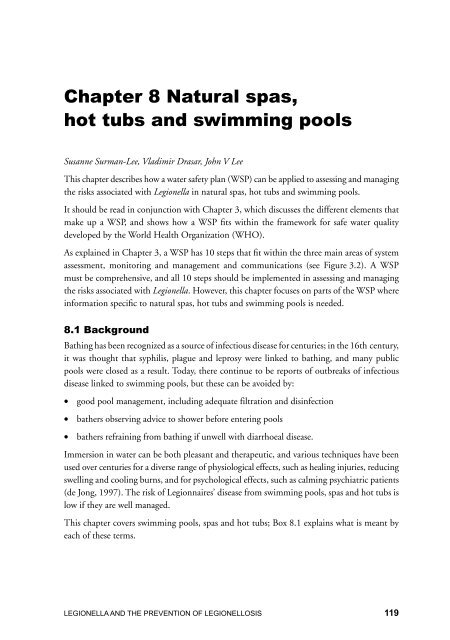LEGIONELLA - World Health Organization
LEGIONELLA - World Health Organization
LEGIONELLA - World Health Organization
Create successful ePaper yourself
Turn your PDF publications into a flip-book with our unique Google optimized e-Paper software.
Chapter 8 Natural spas,<br />
hot tubs and swimming pools<br />
Susanne Surman-Lee, Vladimir Drasar, John V Lee<br />
This chapter describes how a water safety plan (WSP) can be applied to assessing and managing<br />
the risks associated with Legionella in natural spas, hot tubs and swimming pools.<br />
It should be read in conjunction with Chapter 3, which discusses the different elements that<br />
make up a WSP, and shows how a WSP fits within the framework for safe water quality<br />
developed by the <strong>World</strong> <strong>Health</strong> <strong>Organization</strong> (WHO).<br />
As explained in Chapter 3, a WSP has 10 steps that fit within the three main areas of system<br />
assessment, monitoring and management and communications (see Figure 3.2). A WSP<br />
must be comprehensive, and all 10 steps should be implemented in assessing and managing<br />
the risks associated with Legionella. However, this chapter focuses on parts of the WSP where<br />
information specific to natural spas, hot tubs and swimming pools is needed.<br />
8.1 Background<br />
Bathing has been recognized as a source of infectious disease for centuries; in the 16th century,<br />
it was thought that syphilis, plague and leprosy were linked to bathing, and many public<br />
pools were closed as a result. Today, there continue to be reports of outbreaks of infectious<br />
disease linked to swimming pools, but these can be avoided by:<br />
• good pool management, including adequate filtration and disinfection<br />
• bathers observing advice to shower before entering pools<br />
• bathers refraining from bathing if unwell with diarrhoeal disease.<br />
Immersion in water can be both pleasant and therapeutic, and various techniques have been<br />
used over centuries for a diverse range of physiological effects, such as healing injuries, reducing<br />
swelling and cooling burns, and for psychological effects, such as calming psychiatric patients<br />
(de Jong, 1997). The risk of Legionnaires’ disease from swimming pools, spas and hot tubs is<br />
low if they are well managed.<br />
This chapter covers swimming pools, spas and hot tubs; Box 8.1 explains what is meant by<br />
each of these terms.<br />
<strong>LEGIONELLA</strong> AND THE PREVENTION OF LEGIONELLOSIS

















